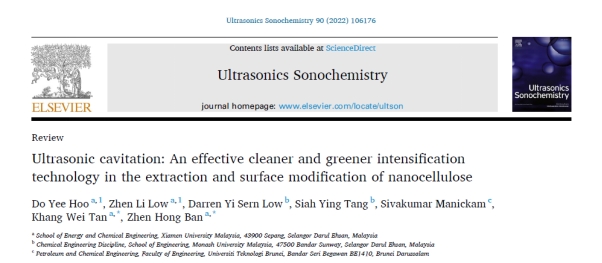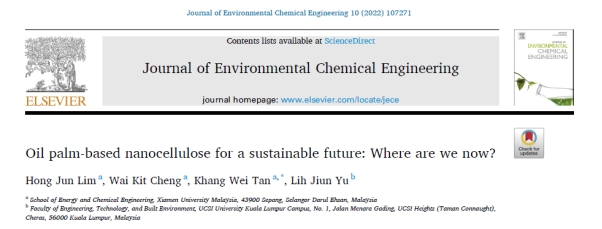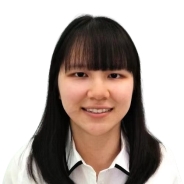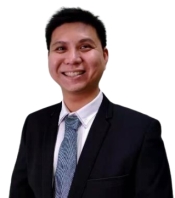The Research and Postgraduate Centre congratulates Hoo Do Yee, Low Zhen Li, Lim Hong Jun, Associate Professor Dr. Tan Khang Wei, and Assistant Professor Dr. Ban Zhen Hong for the recent articles published in Ultrasonics Sonochemistry and Journal of Environmental Chemical Engineering, which are SCI Q1 journals with the latest impact factor of 9.336 and 7.968, respectively.
Hoo Do Yee, Low Zhen Li and Lim Hong Jun are graduates of Chemical Engineering Programme. Currently, Hoo Do Yee and Lim Hong Jun are pursuing their Master’s/PhD degrees under the supervision of Dr. Tan Khang Wei, while Low Zhen Li is working as a metrology engineer at Micron Semiconductor Asia in Singapore.
The first article “Ultrasonic cavitation: An effective cleaner and greener intensification technology in the extraction and surface modification of nanocellulose” is a critical review of the utilization of ultrasonic cavitation in nanocellulose fabrication. This review shed light on the potential and recent development of ultrasound applications to alleviate the current nanocellulose extraction methods for more effective and greener nanofabrication. Diversified applications, significant roles, and challenges of ultrasound are thoroughly recounted, along with future recommendations.
This study was conducted in collaboration with Prof. Sivakumar Manickam from the University of Technology Brunei and Dr. Patrick Tang Siah Ying from Monash University Malaysia. The authors would like to express their gratitude to Xiamen University Malaysia for the financial support through Xiamen University Malaysia Research Fund (XMUMRF/2022-C10/IENG/0048 and XMUMRF/IENG/0002).

The article can be accessed at https://doi.org/10.1016/j.ultsonch.2022.106176.
The second article is entitled “Oil palm-based nanocellulose for a sustainable future: Where are we now?”. Albeit the great success of the palm oil industry in the past few decades, it remains very challenging for the sector to seek more sustainable development in the circular economic business ecosystem. In this paper, the authors provided a comprehensive review of the recent advancements of oil palm-based nanocellulose from its initial isolation and characterizations to the final applications. The challenges and opportunities for the future development associated with the commercialization of nanocellulose-based materials were also thoroughly canvassed. It also indicated an important milestone to make Waste-to-Wealth a reality.
This study was conducted in collaboration with Dr. Yu Lih Jiun from UCSI University, with financial aid through Xiamen University Malaysia Research Fund (XMUMRF/2019-C3/IENG/0014).

The article can be accessed at https://doi.org/10.1016/j.jece.2022.107271.
| Hoo Do Yee: “It is intriguing to uncover the potentials and challenges of ultrasound in greener nanocellulose extraction as we delved into the topic. I must thank my supervisor, Dr. Tan Khang Wei for all the knowledge he has enlightened me with, and my research peer, Low Zhen Li as well as other authors for their tireless efforts and persistent support.” |
| Low Zhen Li: “It is of utmost honor to be able to publish this review paper in Ultrasonics Sonochemistry. I would like to extend my gratitude to my peer, Do Yee, as well as my supervisor, Dr. Tan Khang Wei. His continuous guidance and endless sharing of knowledge in this field have made this publication possible. Having said that, I hope this review can provide better insights and widen the prospects towards ultrasound-assisted extraction of nanocellulose in the future.” |
| Dr. Tan Khang Wei is currently an Associate Professor at Xiamen University Malaysia. Before this, he was a research fellow (BK21 PLUS) at Kyung Hee University (Korea) focusing on process system engineering. Dr. Tan is actively engaged in academic-industry collaboration. To date, in the role of the principal investigator, he has received more than RM 1 million in grants in the area of cellulose nanomaterials, including a nationally competitive research grant, ERGS from MOE in 2013. |
| Dr. Ban Zhen Hong is currently an Assistant Professor at Xiamen University Malaysia. His research area focuses on Computational Fluid Dynamics (CFD) and artificial intelligence (AI). He has successfully delivered three industrial research projects during his engagement at Xiamen University Malaysia. His teaching experience includes Chemical Process Safety, Modelling and Simulation, and Engineering Drawing. |










